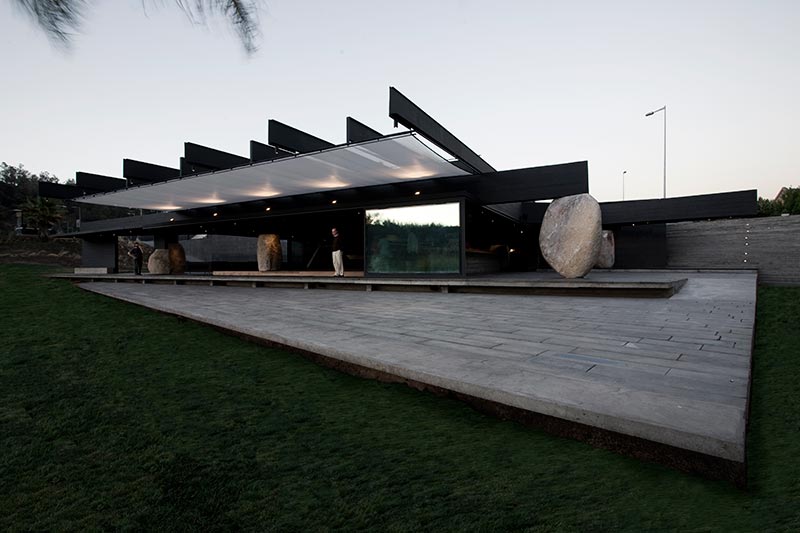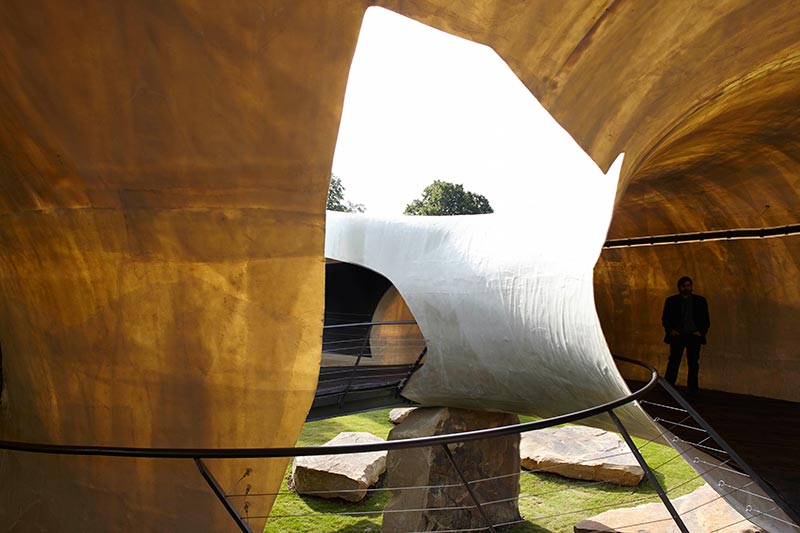A semi-translucent biomorphic pod resting on a bed of boulders forms this year’s Serpentine Pavilion. Designed by Chilean architect Smiljan Radić, it is the 14th commission in the series. In comparison to some of the starchitects previously commissioned (such as Jean Nouvel, Frank Gehry and Peter Zumthor) Radić is not widely known. His contribution follows that of emerging Japanese architect Sou Foujimoto, whose cloud-like immersive grid structure was presented last year. Together, their designs represent a welcome and interesting diversification of the Pavilion series, perhaps suggesting a more general shift towards younger, emerging architectural talent at the Serpentine.
The annual summer Pavilion is an eagerly awaited temporary addition to the landscape of London’s Hyde Park – and it’s exciting when the structure’s design forms a particularly strong bond with its surroundings. Not all previous pavilions have been successful in this respect, and some fell into the mode of stiff and self-contained iconic miniature-buildings. However Radić’s design succeeds with a fluid and open-ended structure that interacts with its natural context, while also offering an interesting nod to the architectural tradition of the garden folly.
The Pavilion’s principal element is a large, off-white cylindrical structure made of fiberglass (glass-reinforced plastic), with roughly cut-out edges and a hollow interior. Densely layered in the manner of papier-mâché, the cylinder’s individual component sheets are visible to the eye, and create varied levels of semi-transparency along the thin walls. They have a strangely appealing tactile quality – few visitors can resist reaching out to touch. A spiralling ramp of wooden decking forms the Pavilion’s floor, while a suspended zigzag lighting element accentuates the walking route. The interior adheres to the usual Serpentine Pavilion programme, housing a café and flexible event space.
The natural white tones along with the spiralling cut give the whole structure a shell-like feel, while the large boulders at its base, roughly-hewn and unpolished, further augment these associations with nature. The base also enables a more fluid transition between the park’s earthy ground and the seemingly floating fiberglass shell (the illusion of weightlessness only slightly hampered by the visibility of the thick structural beams that connect the cylinder with the rocks beneath) – granting the structure a subtle unity with its surroundings.
Its not the first time Radić has worked with rocks in his architecture. His contribution at the 2010 Venice Architecture Biennale included a hollowed-out Andean boulder, while schemes like his Mestizo restaurant in Santiago, Chile also included roughly-hewn boulder elements. The architect frequently juxtaposes designed elements and the chance natural effects of organic objects such as rocks, broken and weathered by natural cycles.
Mestizo Restaurant Santiago, Chile (2005–07), Smiljan Radić. Photograph by Gonzalo Puga © Smiljan Radić.

In the Serpentine Pavilion, the overall effect is one of both lightness and playfulness that captures the spirit of Mannerist or 19th-century garden follies, designed to amuse, interest and surprise their visitors. It is a resonance that feels particularly appropriate in the context of a public park. The shell-like shape of the structure coupled with natural rock uses a design vocabulary that harks back to such historic pleasure grottos, famously set in shell-lined caves. Only here, Radić offers the folly in a more 21st-century material guise. A place to enjoy this summer.
The Serpentine Pavilion will remain open at the Serpentine Gallery until 19 October.





